
So many years after the Holidays hit I feel myself needing to regroup and get back on track. And I mean that I need to do this in multiple areas of my life. Usually I’ve gotten myself into some habits like staying up too late, skimping on my exercise and bringing WAY too much into the house for decor and just overall stuff.
Each year I need less and less of a reset as I’ve learned to keep things a bit more under control during the holidays. But still, even this year, I’m ready to do a minor reset and get those healthy habits back on track.
One of the things that has helped me SO much is participating in a “No Spend Challenge.” Not only does my bank account benefit from this, but it’s a great way to reset and pay VERY close attention to what is actually coming into your house. It’s also a great way to reset your mindset and start thinking through every purchase with a different filter.
The filter that I’m referring to I have talked a lot about in the past, it’s being the Keeper of “Your Home.” It means being very intentional with what you’re allowing into your house and what you’re purchasing. When you pair this mindset with a month long no-spend challenge, you’re house will reap the benefits.
WHAT IS A NO-SPEND CHALLENGE?
This month, (the month of January), I’m taking part in a self-imposed no-spend challenge. This doesn’t mean I’m not spending ANY money at all. Obviously I still have to buy food and groceries for my family as well as pay for things like school activities, chiropractor appointments, gifts that need to be bought and necessities.
You can make exceptions to your own challenge, or change it to work for you and your family if needed. The rules of how I do mine are simple:
- Food and groceries can be purchased as long as they aren’t being bought as a “stock up”.
- Necessities like toiletries and household cleaning products and goods follow the same rule. It has to be a need at the moment, not a “stock up purchase”.
- Nothing else is bought or purchased. (This includes home decor, clothing, beauty splurges, etc.)
That’s it. It makes me think before EVERY. SINGLE. PURCHASE. “Do I need this?”. That question is like my filter for purchasing this month. Any purchase must be a YES and pass the filter of “Do I need this?”
I also don’t allow myself to buy things just to stock up. If I buy something at the grocery store it’s for a recipe I’m making that week. However, as part of this challenge, I try to make meals that use up frozen food and food in my pantry so that I truly am not buying as much as I normally would.
The same goes for toiletries and house supplies. I make every effort to use up everything I have before I even think about purchasing more. It’s easy to quickly obtain a stockpile of soaps, cleaners and shampoo.
I’ve also found it helpful to use a list to keep track of exactly what I need. If something’s not on the list as a need or a replacement product, I don’t buy it.
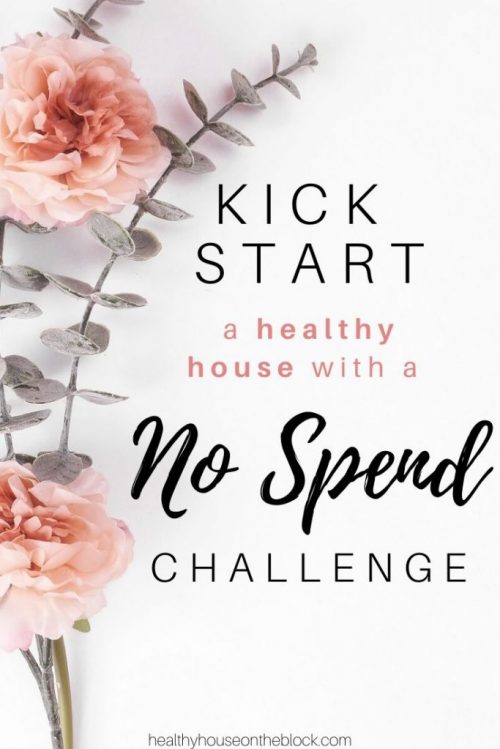
HOW IT HELPS YOUR HOUSE
You might be wondering just how this type of challenge can help improve your house. It’s really simple; the more you have in your house, generally, the more toxins you have too. Every item you bring into your house has the potential to bring in a set of toxins through plastics, treated fabrics, cleaners and air fresheners.
By limiting what you’re buying and pairing it down to JUST what you need, you’re eliminating introducing toxins to your home.
Another part of this is that you’re allowing yourself to really THINK about what you’re purchasing before you buy it. This is an awesome time to rethink your beauty products, cleaning solutions and other items you purchase that may contain toxins. By thinking it through you’re likely making a more positive choice.
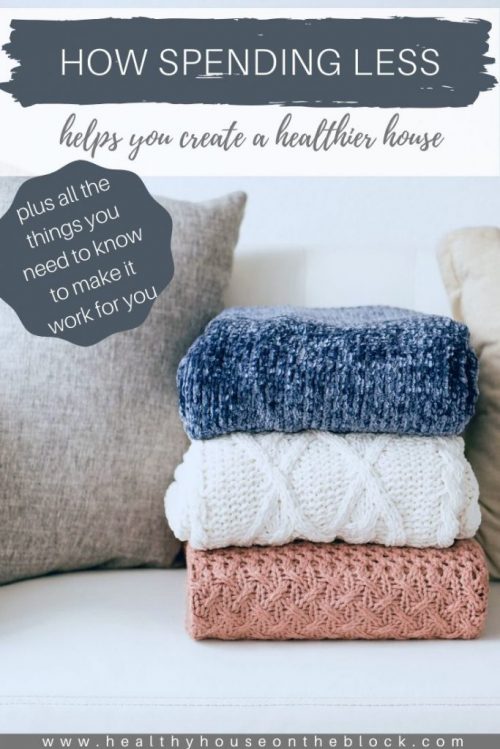
HOW IT HELPS IN TERMS OF SUSTAINABILITY
Using up what you have is always the best policy. Stocking up and hoarding things not only leads to clutter, but often times it leads to waste too. Waste in the sense that things go bad, sit past their expiration, or get completely forgotten about.
When this happens, we not only waste our money, but also add to the problem of wastefulness we already have.
Every time something gets thrown away, not only are resources spent to manufacture and ship the new item we’re purchasing, but there is also a plethora of resources spent to dispose of our old items.
Holding off on buying something just because we want it can save resources in product delivery and waste.
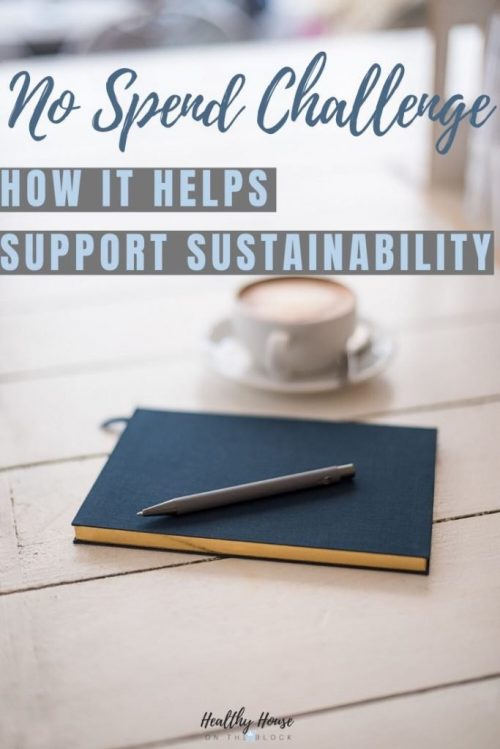
SOLUTIONS INSTEAD OF BUYING & SPENDING
Repair/Fix Instead of Buy New: So many of us (myself included!) have come to adopt the mentality that if something isn’t perfect or it needs a repair, we have no use for it. It’s a far cry from our grandparents and great-grandparents, who just a few generations ago repaired and fixed first before buying new. This led to a lot less waste, a lot less spending, and a lot less instant gratification. If you’re convincing yourself that you have to buy something to replace a not-so-perfect item, analyze it and see if maybe it could use a repair, cleaning or fix in some way.
Use Up What You Have: This is the best policy when it comes to food, personal products and home supplies. Don’t be the stock up queen (or king!). Dont keep a pantry filled to the brim — this is the month to use that stockpile up! It might be a bit of a challenge at first. But I’ve even taken it so far as using up all the different kinds of granola bars before buying even one new box.
Reuse and Repurpose: I shared this idea in the Keeper of Your Home post. You don’t have to wait to buy something new to change the decor in a room. You can move furniture around and move furniture to different rooms if you want. This is such a great way to get a totally new feeling room without spending any money.
Do you have left over paint? That’s another way to spruce up a room and give it a new feel without buying something. Or you might have a stash of decor items that haven’t been out for a while. You can use those instead of buying something new.
Get Crafty/Make It: I’ve used this plenty of times when I’ve been in a pinch and couldn’t get out to a store. I’ll bet I’m not alone when it comes to having a small craft store inside my house. I have more paper, ribbon and craft odds and ends than I know what to do with. These supplies don’t have to be used for just the kids. They can be used to make gifts, add a new design element to the house or or to take the place of spending money on an activity or toy.
The same goes for cleaning products and beauty products if you’re up for the challenge.
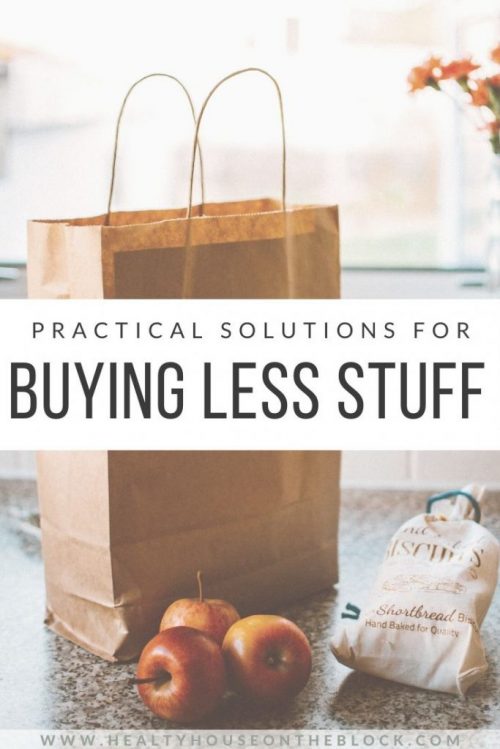
WHAT A NO-SPEND CHALLENGE IS NOT
A no spend challenge is not just a spending deferral until next month. Instead, it’s meant to make you think, change habits and use up what you have first. There are families who do no-spend challenges for the whole year and have absolutely positive results.
So instead of having the mindset that you’ll just buy it next month when the challenge is over, make a conscious effort to really think that purchase through. Remember, the whole point of this challenge is to be extremely intentional with what is coming into your house.
A no-spend challenge is also not meant to be super easy. It will be a challenge at first. But any change we try to make in our lives is usually a bit uncomfortable at first. But growth doesn’t come without getting a little uncomfortable first.
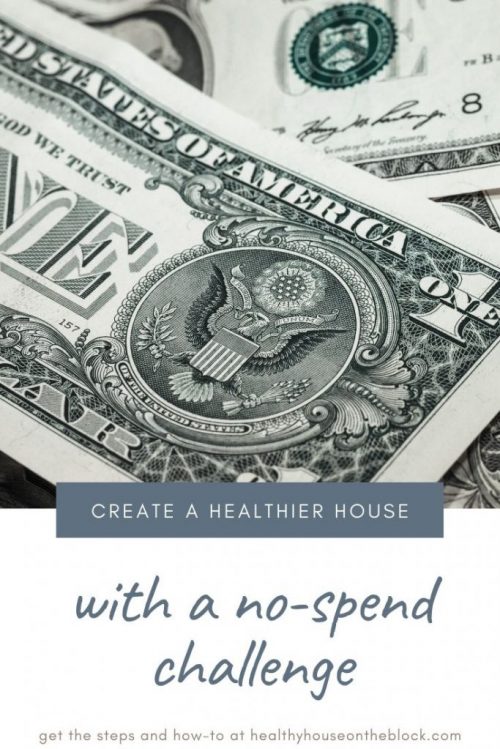
SET YOURSELF UP FOR SUCCESS
Make Rules Ahead of Time: If you’re doing the challenge with your family or by yourself, it’s a good idea to set ground rules before hand. You can even go so far as to write them down so there’s no confusion. Decide on things that will “pass the need test”. Will you allow any groceries, or just the necessities? Will you let beauty treatments slide, or will you put them on hold? You pick and stick to those decisions.
Avoid Temptation: Another way you can set yourself up for success is by not putting yourself in situations where you’ll want to spend money and buy new things. That means avoiding stores you like to browse in (Hello, Target!), don’t go on Amazon unless you need to and don’t even think about swiping up on Instagram. By avoiding these situations, you can avoid the temptation to buy something new in the first place.
Budget & Keep Track: A bonus idea is to set yourself up with a budgeting app or spreadsheet that will help you keep track of exactly what you’re buying. This will not only help hold you accountable to what you’re buying, but it also helps you analyze purchases after the fact. It’ll help you improve your no-spending challenge as you go.
Accountability: I’m SO excited to be offering a Facebook Pop Up Group to help give you ideas and support as you do this no-spend challenge. You can also ask a spouse, friend or family member to help keep you accountable as well.
Starting on Friday, January 10th, my No-Spend Challenge will run for 1 month (Until February 9th). I’m going to be sharing daily ways to change your purchasing habits for your home and how to really succeed at this challenge.
Plus you’ll be joined by others to bounce ideas off of and get support from as we do this New Year reset of our buying for our homes.

Simply put, it’s choosing only to spend money on absolute necessities.
The rules of how I do mine are simple:
1. Food and groceries can be purchased as long as they aren’t being bought as a “stock up”.
2. Necessities like toiletries and household cleaning products and goods follow the same rule. It has to be a need at the moment, not a “stock up purchase”.
3. Nothing else is bought or purchased. (This includes home decor, clothing, beauty splurges, etc.)
That’s it. It makes me think before EVERY. SINGLE. PURCHASE. “Do I need this?”. That question is like my filter for purchasing this month. Any purchase must be a YES and pass the filter of “Do I need this?”
I also don’t allow myself to buy things just to stock up. If I buy something at the grocery store it’s for a recipe I’m making that week. However, as part of this challenge, I try to make meals that use up frozen food and food in my pantry so that I truly am not buying as much as I normally would.
The same goes for toiletries and house supplies. I make every effort to use up everything I have before I even think about purchasing more. It’s easy to quickly obtain a stockpile of soaps, cleaners and shampoo.
Join the Facebook Group Here to Get Started




This is a smart challenge to give yourself in the new year! I’m glad you says it’s not a spending deferral – you definitely shouldn’t go crazy spending the next month lol. I’ll use your tips the next time we have a no-spend month!
You have really, really, *really* thought this no spend challenge through. Kudos to you!!! Hubby and I are starting this year with a new budget, using a new app. That’s our big start to the new year and the new decade. I’m sending you good vibes for a successful no spend January. Thanks for sharing all of your detailed thoughts here…really great ideas. Thank you!
I fully agree with your approach and use some of your techniques to succeed. My favourite for Jan is to use most of the food that is in my freezer. And using items I have already in my pantry for some time and keep avoiding them for some reason. That way I come up with new ideas and recipes on how to use what I have, clean my cupboards and get ready to start over again.
I think this is a great idea! We did a no-spend October and it was really amazing how little we were able to spend!
This is a great idea! I’ve heard of doing a no-shopping month (or no-shopping SUMMER!) but I have never actually committed… This is inspirational though!